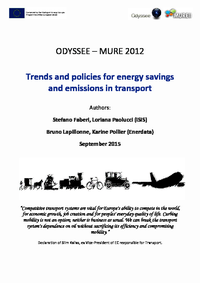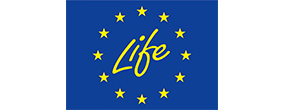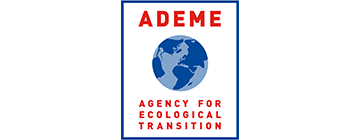Summary
This brochure proposes an evaluation of energy efficiency progress achieved by mode in transport since 2000, with a focus on cars for which significant progress has been achieved. It shows the great impact of the economic crisis on the energy trends.
It also looks at the EU and national policies and measures implemented in that sector: the majority of them concern passenger modes and especially cars. It analyses in depth measures on modal shift and those concerning non-conventional fuels.
Key Messages – Energy Efficiency Trends and Policies in Transport
Energy Consumption and Efficiency Trends
- The energy consumption of the transport sector has been decreasing quite rapidly since 2007.
- Around 40% of that reduction is due to the economic recession, with a decrease in freight traffic and the stability of passenger traffic. Almost 60% is due to improvements in energy efficiency, mostly for passenger cars.
- As a result of these trends, transport energy consumption in 2013 was almost the same as in 2000 at EU level and in France, and between 3% and 10% below in Germany, Italy, UK and Spain.
- Since 2007, the economic crisis resulted in a remarkable drop in the traffic of goods which was in 2012 11% lower than in 2007 at EU level. Passenger traffic remains stable despite population growth because of a slight decrease in passenger mobility (decrease by 3% of km travelled per capita per year). In addition, in most countries the average annual distance travelled by cars has been decreasing since 2007.
- The energy efficiency of transport improved by 1.2% per year in the EU between 2000 and 2013. Greater progress was achieved for both cars and airplanes than in the rest of the sector. Energy efficiency progress has slowed down for trucks and light goods vehicles since 2005 and even has virtually stopped since 2007: the fall in freight activity (by 2.5%/year over 2007-2012) led to less efficient operation of the vehicle fleet, as shown by the sharp decrease in load factors (trucks less loaded with increased empty running).
- The average specific consumption of the car fleet decreased from 8.1 l/100 km in 1995 to 6.8 l/100 km in 2012 at EU level, thanks to the progress achieved with new cars.
- The reduction in the specific consumption of new cars has accelerated since 2007 (- 3.7% per year compared to 1.5% between 2000 and 2007), mainly because of EU regulations on labelling and emission standards and national fiscal policies promoting the purchase of low emission cars. This acceleration was especially rapid in the Netherlands, Ireland, Sweden, Denmark, Finland and UK, where it was above 4% per annum.
- There are now 11 countries in the EU with a specific consumption of new cars below 5 l/100km with Portugal, the Netherlands and Denmark in the lower range. The high share of diesel cars largely explains the good performances of these countries.
- All countries aim at decreasing the share of road in transport, as a way to decrease consumption and emissions. The results are not as bright as the share of public transport in total passenger traffic was the same in 2012 as in 2000 at EU level (18.5%) and the share of rail and water has been decreasing for freight transport.
- The stability in the share of public transport is the result of opposite trends with a decrease in the majority of countries but an increase in 11 countries, among which the largest countries. The Czech Republic and Austria have the highest use of public transport (around 3,000 km/year/person), compared to an EU average around 2,000 km. Belgium and Croatia recorded the highest increase in the share of public transport since 2,000 (over 30%).
- For freight, the Netherlands and Sweden appear as the benchmark for all other countries as they have the highest share of rail and water transport (respectively 53 and 46%) and are among the countries where this share is progressing.
- For road transport, alternative fuels (natural gas and biofuels) supplied around 5% of the consumption in the EU in 2013, of which 90% for biofuels. Around 75% of the biofuel is biodiesel. Sweden is the leader, followed by France and Bulgaria.
- The transport sector represents an increasing share of total CO2 emissions of final consumers: 43% in 2012 compared to 32% in 1990. Emissions from road freight transport were 33% higher in 2012 than in 1990 and made up 35% of total transport emissions. Emissions from cars have been decreasing since 2000 because of the significant reduction in the specific emissions of new cars.
- In six countries, new car emissions were below 120 g CO2/km in 2013 (the Netherlands, Greece, Portugal, Denmark, France and Malta) and in total 12 countries were below the mandatory limit of 130g for 2015 for cars manufacturers. The share of low emissions cars (i.e. below 100 g CO2/km) increased from 2.5% in 2010 to 15% in 2013 at EU level.
Policies and Measures
- The majority of the transport measures (about 70% of the total) concern the passenger modes with particular emphasis on the private car, and this is reflected in the corresponding energy consumption and traffic trends. In contrast, the approximately 30% of policy measures that directly or indirectly affect freight transport do not seem to have had a tangible impact on the corresponding energy efficiency and traffic indicators.
- In the same way, the approximately 100 measures that address modal shift have not yet been able to noticeably affect passenger mobility habits and freight transport logistics and organization. Positive signs of change are indeed coming from some countries, especially with regards to the passenger modes, but it is too early to judge whether this is due to the measures that have been implemented or to the economic crisis. The energy efficiency potential of modal shifting is very high but is far from being realised.
- The energy efficiency improvements achieved in the private passenger mode seem to be mainly due to three sets of measures that represent the bulk of the energy efficiency policies enacted in this sector (based on the number and the estimated impact of these policies): those concerning the energy and CO2 standards for new cars, those addressed to renew the car fleets and those addressed to traffic management. But to achieve a concrete and irreversible impact on the energy efficiency trends of this sector it is necessary to envisage integrated intervention strategies that impact on all the vehicle energy efficiency components (powertrain, market, use) and on the mobility patterns.
- To this end it would be useful to carry out studies to analyse the interactions and the potential of each of these energy efficiency components taking also into account that, presumably, a not negligible contribution to the energy and CO2 savings come from the local measures.
- It has been noted that the “semi-quantitative” energy impact attributed to the measures differ notably even if these policies have the same aim. This obviously depends on the country context and the measure mechanism and scope but, as a general rule, it would be useful to have reference and official guidelines to calculate such an impact.
- In contrast to the household and services sectors, in the transport sector EU Legislation does not represent the major driver for the implementation of policies and measures. The transport measures related to the EU legislation represent just 20% of total ongoing measures and the majority of them have been issued in the period 2000 – 2010. This means that the issuing of purely national measures is still rather high in this sector, with the possible exception of the measures concerning the introduction of biofuel in the fuel market that generally refer to the corresponding EU Directive 2003/30/EC.
Archives
Energy Efficiency Policies in Transport in the EU: October 2012




